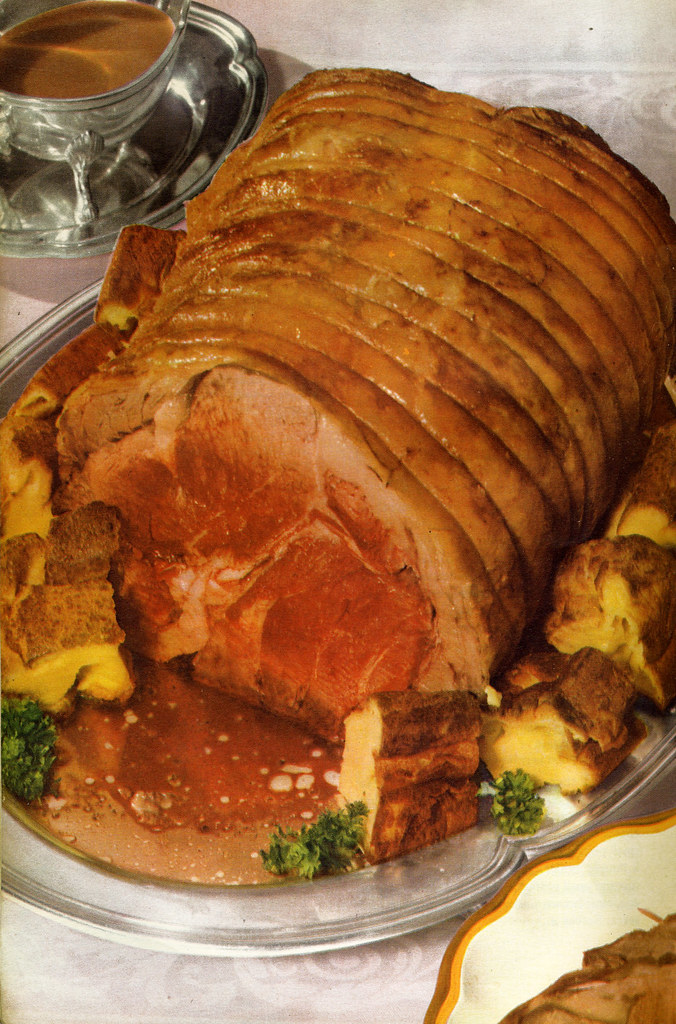from the Carnation Cook Book
I want to get specific about what constitutes "grass-fed beef," because I've had producers tell me their beef is grass fed "and then corn finished." All beef is grass fed to a certain point. However, most steers end their lives in a feedlot where they stand around on a concrete floor with a bunch of other steers and are fed corn until they reach slaughter weight. When I say "grass-fed beef," I mean beef that has stayed on the pasture its entire life. Of course, even a grass-fed steer will eat hay in the winter or during other lean times, but that's part of his natural diet.
Grass-fed beef is a pre-industrial ingredient, so we must look at how pre-industrial peoples prepared it:
- If grass-fed beef is to be dry cooked (grilled, roasted, sautéed), it should be cooked to rare or medium-rare (to keep it nice and juicy) and requires the addition of cooking fat.
- Grass-fed beef should only be cooked to well-done if moist heat is involved (boiling, braising).
I say "good," because I've had my fair share of indifferent and even bad grass-fed beef. It all depends on the producer and the breed. For example, I really love the beef from Turkey Foot Ranch, which is only about 50 miles from my house and they sell their products in the freezer section at my local health-food store. They raise red and black Angus, which is a very tasty breed. It's worth finding out what breed a producer raises, because each tastes differently. My personal favorites (so far) are Angus and Charolais.
What about cost? I firmly believe that the desire for healthy, tasty food is not elitist. It is possible to find reasonably-priced grass-fed beef; you only need to do a bit of research (see the Resources section). For example, the KC Strip from Turkey Foot Ranch is $12 per pound. Yes, it absolutely costs more than feedlot beef, but it's worth every penny.
However, if grass-fed beef's superior, succulent taste hasn't convinced you, here are a few things I've learned from doing my own research* on the subject:
- Grass-fed beef has more omega-3s than grain-finished beef
- Grass-fed beef has higher concentrations of vitamins A and E
- Grass-fed beef has more lutein and beta-carotene
- Grass-feeding reduces the occurrence of e.coli
Recipes for dry heat:
Old English Roast Beef
Roast Beef with Cabernet Gravy
Steak frites
Recipe for moist heat:
Boiled Beef with Carrots and Dumplings
Resources:
Local Harvest
Eat Wild
Eat Well Guide
Further reading/watching:
Food, Inc.
The Householder's Guide to the Universe by Harriet Fasenfest
Nourishing Traditions by Sally Fallon
The Omnivore's Dilemma by Michael Pollan
Real Food by Nina Planck
*This information is found both in Nourishing Traditions and Real Food, along with a lot of good information on the importance of high-quality animal fats in our diet.
**Let me know in the comments if you have a favorite recipe for using grass-fed beef (or anything else to add). Please be sure to leave a link for me if you have one. Thanks!
Edited 8/25/11: This post is now linked to Fat Tuesday Forager Festival at Real Food Forager.
Yesterday on The Past on a Plate: "Feasts and Festivals: St. Bartholomew's Day"


Informative. Thanks for this.
ReplyDeleteAs a Lifestyle Educator, this is a big one for me (despite the fact that I eat brownies when no one is looking). Seeing as it's an overall healthier choice, I don't mind paying extra. I also love that you buy local. :)
ReplyDeleteThanks for the information - now I just have to figure out where to get it locally!
ReplyDeleteGreat information...I'm going to have to see what my Whole Foods sells.
ReplyDeleteI'm happy you are sharing this information. We balance out paying a bit more for meat by eating less of it, which I think is better all around. (I actually stopped eating meat when we got our chickens, but I live in a family of carnivores.)
ReplyDeleteI would also add that if you buy your beef from a real butcher shop (or directly from the farmer, of course) you will get a better product. All supermarket beef is vacuum-packed and shipped for miles, and may have been stored for weeks if not months. Any real butcher shop that brings in whole animal or carcass beef must have a high turnover and fresher product. It will also be more likely to be dry aged and cut to order in front of you. If you support the local butcher shop you will also support the local food chain!
ReplyDelete